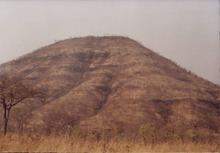Named by G.W. Lamplugh | Other Sandstone Primary Basalt | |
 | ||
Overlies Forest Sandstone Formation Unit of | ||
The Batoka Formation is a geological formation in the Zambezi valley in Botswana, Zambia and Zimbabwe. It is mainly a volcanic unit, comprising mainly basalts, with Lower Jurassic sandstone that contain Vulcanodon fossils.
Contents
Description
The formation is a volcanic unit, consisting mainly of high-titanium, low-potassium tholeiitic basalt flows with small layers of aeolian sandstone and siltstone between some of the flows.
The lavas are dark, vesicular and porphyritic or massive basalts, with occasional pillows although rare dacites and rhyolites have been reported from some areas of north-eastern Botswana. The vesicular and massive basalts occur in alternating bands, with the vesicular bands usually being the top and base of each flow. The basalt mineralogy consists of mainly of plagioclase, augite, magnetite, some ilmenite and volcanic glass. In the Hwange area, vesicles consist mostly of quartz, chalcedony or calcite, though zeolites, such as stilbite, mesolite and laumontite, are dominant towards Victoria Falls and in the lower Deka valley and are common in north-eastern Botswana.
The basalt lavas are related to carbonatite intrusions in the Zambezi valley.
Extent
The Batoka Formation is found in Botswana, Zambia, Zimbabwe, in the Mid-Zambezi, Mana Pools and Cabora Bassa basins
Age
Lavas of the Batoka Formation have been dated at 179 to 180 Ma.
Stratigraphy
The Batoka Formation is the uppermost formation in the Upper Karoo Group of the Karoo Supergroup, lying above the Forest Sandstone Formation.
The Batoka Formation has been correlated to the Drakensberg Group of the Great Karroo Basin, South Africa and the basalts of the Tuli Basin in Botswana and Zimbabwe.
